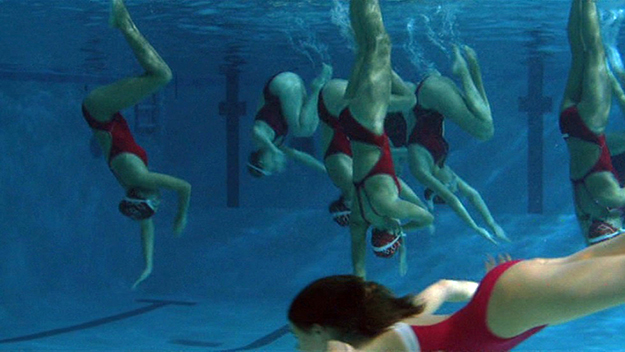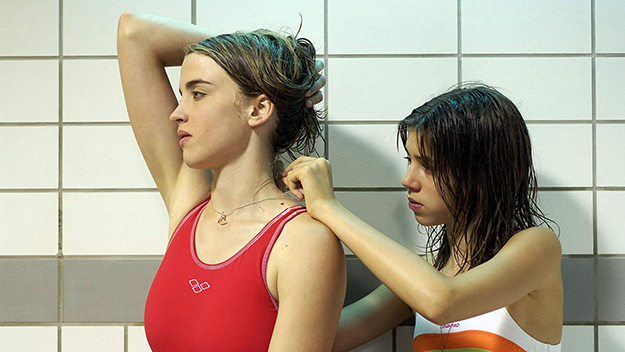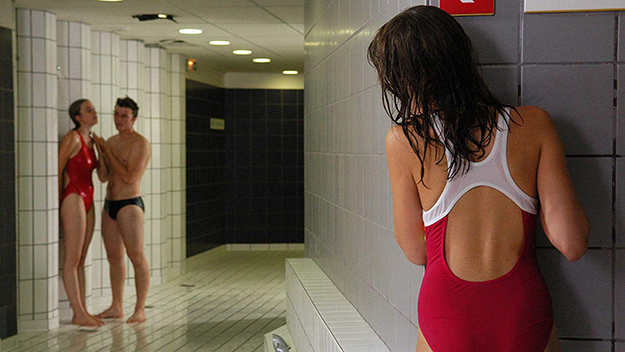Images from Water Lilies (Céline Sciamma, 2007) Throughout Céline Sciamma’s meticulous Portrait of a Lady on Fire, we’re made fully conscious of three distinct yet interconnected points of view at once: those of the artist, the subject of the artist’s gaze (in classical—and in this case, outdated—parlance “the muse”), and our own, as the viewers of the finished artwork, which is, in this case, a film. Sciamma’s film feels at all times like a revelation not because there haven’t been movies to engage with these questions of perspective, but because when it comes to queer art, the conventions of looking—and the presumptions about who is looking—have rarely been questioned. What’s specifically resounding in Portrait is the agency it gives the painter’s subject: Héloïse (Adèle Haenel), the woman whose visage is being committed to canvas. Héloïse’s refusal to sit for her wedding portrait before finding an erotic connection with a female painter, Marianne (Noémie Merlant), is powerful enough as a dramatic conceit. Yet Sciamma goes even further in ensuring that when she finally allows for the portrait to happen, its creation becomes a shared act—a rare work born of artistic equality. Héloïse—and Haenel—controls the artist’s, and our, gaze completely: the queer object of our attention is fully aware of her status in the frame. The dynamic of a queer or queer-ish performer implicitly exerting power over the viewer has existed in cinema at least as early as a tuxedoed Marlene Dietrich strutted through the nightclub in Morocco and, before Portrait, as recently as Lee Kang-sheng has held the screen in any one of the films by his most ardent admirer, Tsai Ming-liang. And Sciamma, a lesbian filmmaker, has been asking these specific questions about the power of looking and being looked at since her very first film. Directed by Sciamma when she was just 27, the coming-of-age drama Water Lilies features a short but revealing scene in which a teenaged Haenel is having a locker-room conversation with another girl on her synchronized swimming team. This unnamed minor character (Alice de Lencquesaing) tells Haenel’s Floriane that she refuses to peel and eat bananas whole because of how boys lasciviously interpret the gesture, their puerile brains transforming it into an implicit sexual act. Floriane shrugs that she is well aware of this, before defiantly and sensually taking another bite of her banana. In this moment, both women are attempting to reject being controlled by men’s eyes, though only one believes she is accruing power by accepting their gaze. Floriane, who claims to be sexually experienced, will not be shamed into not eating the fruit, nor, it’s implied, will she deny that she enjoys being the subject of another’s stare, and that her knowledge of this gives her power over who’s looking.
From this early starring role—her second film following her debut performance as a preadolescent in 2002’s Les Diables—Haenel is a fascinating, complexly self-aware camera subject, even in a film in which she plays a character constantly negotiating the pains and powers of being objectified. Water Lilies immediately subverts accepted notions of who is watching and who’s being watched—and who accepts or rejects that gaze. The central narrative is itself initiated by an act of watching. From the start, it is the perspective of high-schooler Marie (Pauline Acquart) with which we’re most fully aligned, even if, initially, she’s just part of the crowd, watching the synchronized pool performance that opens the film. From her quietly captivated reaction shots, we follow her eye-line directly to Floriane. With her nose clips and glued-on maniacal smile, this presentational version of Floriane looks nothing like the appealingly ambivalent Haenel we’ve become more accustomed to seeing on screen in such films as BPM (Beats Per Minute), The Unknown Girl, and Portrait—and it’s certainly different from the scowling face Haenel wears as she exits the locker room before plowing past Marie after the performance. Nevertheless, Marie quickly grows infatuated with her classmate. The odd, constantly shifting power dynamic of their exchange is set in motion upon their first real interaction in a bathroom during a weekend party. Marie, looking introverted and rumpled in an androgynous polo shirt, tells Floriane, more traditionally feminine as she applies makeup in the mirror, that she looked beautiful in the pool, and even becomes bold enough to ask if she can come to swimming practice just so she can watch Floriane train. Floriane’s momentary instinct is to physically tease Marie—likely how she has been trained to interact with boys her own age—bringing her mouth mockingly close to the girl’s, yet stopping short of touching lips to ask her if her breath stinks before she leaves the room. A bond has been formed. Floriane’s surprisingly open response to Marie’s request to watch her from the sidelines sets up the central ambiguities of the film. Does Floriane have reciprocal feelings for Marie? Or is she just getting off on Marie’s voyeurism? Or is she planning on using Marie’s puppy-dog devotion for other purposes? As Floriane agrees to hang out more with her admirer, other motivating factors arise. When Floriane invites Marie to her house—even sensually writing her address on her hand so she can’t say no—Marie discovers she has been used as a decoy: Floriane just needed to give her parents (unseen, like most adults in the film) as a cover story so she can get out of the house and hook up with her casual boyfriend François (Warren Jacquin) in a nearby garage. Following them along to their destination, Marie ends up as—what else—their lookout.
François functions within another important strand of Water Lilies, even though he’s a somewhat incidental character, and the only male with significant, if purposely limited, dialogue in the film. (With Portrait of a Lady on Fire, Sciamma would most radically strip the frame of men, crucially pushing them to thankless, sidelined walk-ons, if anything.) A member of the all-male water polo team that practices adjacent to the female synchronized swimmers, the handsome François is himself the object of affection for Marie’s best friend, Anne (Louise Blachère), who’s also on the swim team. Tall and insecure, Anne is something of an outcast from the other girls: she crosses herself before a performance (eliciting giggles from teammates) and waits to change out of her clothes only after everyone has left the locker room. Growing up fast, Marie becomes increasingly repulsed by what she perceives as Anne’s childishness, her resentment bubbling to the surface in a scene in which Anne must prove to a McDonald’s cashier (Sciamma, in an amusing cameo) that she’s young enough to order a Happy Meal. It’s a smart reversal of the usual fake-ID scenario, and a reminder of the different speeds at which teenagers age, even as they’re thrown together and let loose in daily survival-of-the-fittest scenarios. While Marie navigates her strange, hesitating, flirtatious relationship with Floriane, Anne nervously pursues François. At one point, Anne gives François a necklace as a sign of devotion; in a subsequent scene, he re-gifts it to Floriane. This awkward quadrangle culminates in a circular sexual irony: Floriane, despite her confident sex talk, admits to Marie she is still a virgin and enlists the girl’s help to “take it away for me,” so that, she believes, she will be adequately prepared to consummate with François. After this disappointing eventuality occurs, François takes surprising refuge in the arms of a startled Anne, perhaps because he, like Floriane, enjoyed being the object of another’s admired gaze. Everyone in Water Lilies just wants to be adored. Yet they’re far too young to find satisfaction. The use of synchronized swimming functions all too well as a metaphor for the experience of being a teenager: it’s at once uncomfortable, rigid, and a complete spectacle, and it lives or dies on the false assumption that young people of different shapes, sizes, and desires could somehow move together in perfect unison. In other words, as a sport, it’s a complete impossibility. Even Marie’s queerness remains a secret to her best friend. When both Marie and Anne lie together in bed at one point, each admits to the other that she is in love. Anne assumes that Marie’s crush is a “him.” Marie hesitates for a moment and then doesn’t correct her. Often the truth is too hard to speak out loud. Later, in the erotically explosive Portrait, Sciamma will refuse to resolve the messy prevarications of young love. Sometimes with desire, what you see is what you get. Michael Koresky is a writer, editor, and filmmaker in Brooklyn. He is cofounder and editor of the online film magazine Reverse Shot, a publication of Museum of the Moving Image; a regular contributor to the Criterion Collection and Film Comment, where he writes the biweekly column Queer & Now & Then; and the author of Terence Davies, published by University of Illinois Press, 2014.


